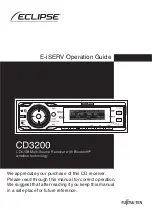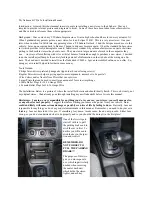
4.
23
(MT13 - En 2015)
4
3) Programming the individual outputs
After programming the cyclic operation, you can program the outputs
to be able to activate them individually by the buttons on the
videointercom. The following tables show the programming se-
quences of the outputs and related illuminations of the LEDs.
Led
ON
Outputs
1A
1B
2A
2B
3A
3B
4A
4B
2D
2E
3D
3E
4D
4E
RG1÷4 RG1÷4 RG1÷4 RG1÷4 RG1÷4 RG1÷4 RG1÷4
LO2
LO3
LO4
LI2
LI3
LI4
7-exchange version
Led
ON
Outputs
1A
1B
1D
1E
2A
2B
2D
2E
3A
3B
3D
3E
4A
4B
4D
4E
RG1÷4 RG1÷4 RG1÷4 RG1÷4
LI2
LO2
LI3
LO3
LI4
LO4
4-exchange version
Return to factory settings
To restore the factory settings, you must:
- enter programming mode by holding down the
SKIP button until the 4 LEDs RG1÷4 light up
sequentially;
- set the micro switches SW1 and SW2 with the
value 85 bringing to ON position the levers 1
and 3 of both micro switches;
- press and hold the OK button until all 6 LEDs
LI2, LI3, LI4, LO2, LO3 and LO4 light up
momentarily; at this point the memory has
been cleared and factory settings are restored;
- press and hold the SKIP button until the LEDs
RG1÷4 start flashing.
OPERATION
The outputs of the selector can be enabled in cyclic mode using one
single button from the videointercom and/or individually by matching
each button of the videointercom to a specific output.
Attention.
- The buttons of the videointercom must be programmed with the
same addresses (codes 211 to 230) of the active outputs of the
selector.
- If the videointercom does not turn on, it is likely that the line is
occupied by another user; try after dial tone.
- During operation, the videointercom may turn off for the following
reasons:
- the 30-second period for turning on the videointercom has
completed;
- a call has been made from an external unit to another user.
Cyclic operation
For cyclic switching, it is necessary, from the videointercoms, to
repeatedly press the button programmed for this function; each press
sequentially switches the active outputs; when the last output is reached,
by continuing to press, the switching restarts from the first output.
Proceed as follows:
a) Zhero series
- press
to turn ON the videointercom;
- press
(symbol on the screen
)to enter the advanced functions;
- press "monitor" to activate the input of the surveillance camera
(terminals M and V of the push-button panel);
- repeatedly press the button programmed for cyclic function (factory
with the sign "actuations").
SERVICE MODULES
- Program the outputs 1 choosing one of the 3 methods described in the
section “how to enter addresses while programming” then press the
SKIP button to switch to the programming of the outputs 2A and 2B
(including 2D and 2E if 4-exchange); in addition to the LEDs RG1÷4
the LED LO2 lights up (and LI2 if 4-exchange).
- Program the outputs 2 choosing one of the 3 methods described in the
section “how to enter addresses while programming” then press the
SKIP button to switch to the programming of the outputs 3A and 3B
(including 3D and 3E if 4-exchange); in addition to the LEDs RG1÷4 the
LED LO3 lights up (and LI3 if 4-exchange).
- Proceed to the complete programming of the selector or exit as shown
in the following section.
d) Exit the programming mode
Press and hold the SKIP button until the flashing of all LEDs RG1÷4 (or
just RG1 if set to 7-exchange).
Attention.
- If no operation is performed for approximately 5 minutes it
automatically exits the programming mode; the data entered up to that
point will be stored.
- Before using the device, do not forget to set the micro switches SW1
and SW2 according to the devices connected to the selector (see next
section).
4 - Activation/deactivation of the outputs
If using the cyclic mode it is recommended to disable the unused outputs
in order to avoid image gaps during the scanning of cameras or non-
activation of functions for other uses. To indicate the outputs used, set the
micro switches SW1 and SW2 to ON (used outputs) or OFF (unused
outputs) according to the following drawing.
+
+
+
2
3
4
211
211
1
ART
.2287
Z
HERO
*
ON
ON
1
1
2
2
3
3
4
4
SW2
SW1
RG1 RG4
SKIP
LI2
LO4
OK
RG1
RG4
SKIP
1D
1E
2D
2E
3D
3E
4D
4E
1A
1B
2A
2B
3A
3B
4A
4B
Yes
Outputs
connected?
No
ON
ON
1 2 3 4
1 2 3 4
SW2
SW1
















































